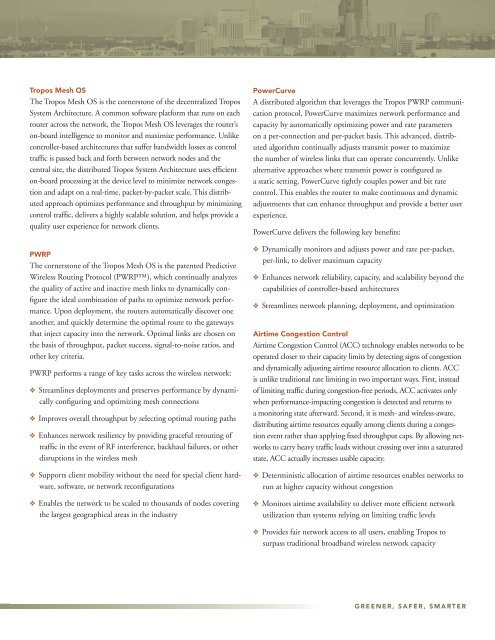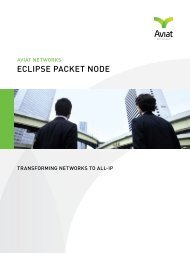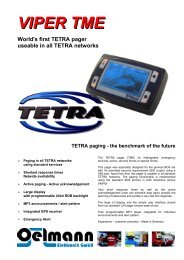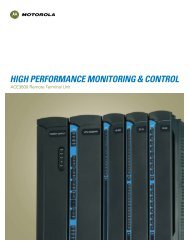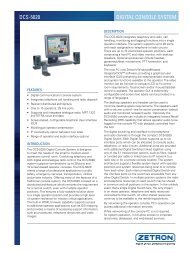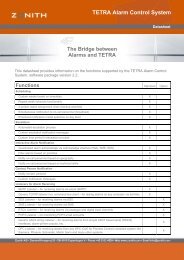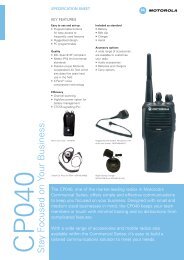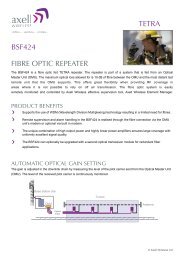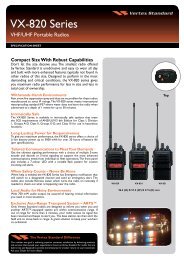Tropos 6320 Datasheet - Sigma Wireless
Tropos 6320 Datasheet - Sigma Wireless
Tropos 6320 Datasheet - Sigma Wireless
You also want an ePaper? Increase the reach of your titles
YUMPU automatically turns print PDFs into web optimized ePapers that Google loves.
<strong>Tropos</strong> Mesh OS<br />
The <strong>Tropos</strong> Mesh OS is the cornerstone of the decentralized <strong>Tropos</strong><br />
System Architecture. A common software platform that runs on each<br />
router across the network, the <strong>Tropos</strong> Mesh OS leverages the router’s<br />
on-board intelligence to monitor and maximize performance. Unlike<br />
controller-based architectures that suffer bandwidth losses as control<br />
traffic is passed back and forth between network nodes and the<br />
central site, the distributed <strong>Tropos</strong> System Architecture uses efficient<br />
on-board processing at the device level to minimize network congestion<br />
and adapt on a real-time, packet-by-packet scale. This distributed<br />
approach optimizes performance and throughput by minimizing<br />
control traffic, delivers a highly scalable solution, and helps provide a<br />
quality user experience for network clients.<br />
PWRP<br />
The cornerstone of the <strong>Tropos</strong> Mesh OS is the patented Predictive<br />
<strong>Wireless</strong> Routing Protocol (PWRP), which continually analyzes<br />
the quality of active and inactive mesh links to dynamically configure<br />
the ideal combination of paths to optimize network performance.<br />
Upon deployment, the routers automatically discover one<br />
another, and quickly determine the optimal route to the gateways<br />
that inject capacity into the network. Optimal links are chosen on<br />
the basis of throughput, packet success, signal-to-noise ratios, and<br />
other key criteria.<br />
PWRP performs a range of key tasks across the wireless network:<br />
❖ Streamlines deployments and preserves performance by dynamically<br />
configuring and optimizing mesh connections<br />
❖ Improves overall throughput by selecting optimal routing paths<br />
❖ Enhances network resiliency by providing graceful rerouting of<br />
traffic in the event of RF interference, backhaul failures, or other<br />
disruptions in the wireless mesh<br />
❖ Supports client mobility without the need for special client hardware,<br />
software, or network reconfigurations<br />
❖ Enables the network to be scaled to thousands of nodes covering<br />
the largest geographical areas in the industry<br />
PowerCurve<br />
A distributed algorithm that leverages the <strong>Tropos</strong> PWRP communication<br />
protocol, PowerCurve maximizes network performance and<br />
capacity by automatically optimizing power and rate parameters<br />
on a per-connection and per-packet basis. This advanced, distributed<br />
algorithm continually adjusts transmit power to maximize<br />
the number of wireless links that can operate concurrently. Unlike<br />
alternative approaches where transmit power is configured as<br />
a static setting, PowerCurve tightly couples power and bit rate<br />
control. This enables the router to make continuous and dynamic<br />
adjustments that can enhance throughput and provide a better user<br />
experience.<br />
PowerCurve delivers the following key benefits:<br />
❖ Dynamically monitors and adjusts power and rate per-packet,<br />
per-link, to deliver maximum capacity<br />
❖ Enhances network reliability, capacity, and scalability beyond the<br />
capabilities of controller-based architectures<br />
❖ Streamlines network planning, deployment, and optimization<br />
Airtime Congestion Control<br />
Airtime Congestion Control (ACC) technology enables networks to be<br />
operated closer to their capacity limits by detecting signs of congestion<br />
and dynamically adjusting airtime resource allocation to clients. ACC<br />
is unlike traditional rate limiting in two important ways. First, instead<br />
of limiting traffic during congestion-free periods, ACC activates only<br />
when performance-impacting congestion is detected and returns to<br />
a monitoring state afterward. Second, it is mesh- and wireless-aware,<br />
distributing airtime resources equally among clients during a congestion<br />
event rather than applying fixed throughput caps. By allowing networks<br />
to carry heavy traffic loads without crossing over into a saturated<br />
state, ACC actually increases usable capacity.<br />
❖ Deterministic allocation of airtime resources enables networks to<br />
run at higher capacity without congestion<br />
❖ Monitors airtime availability to deliver more efficient network<br />
utilization than systems relying on limiting traffic levels<br />
❖ Provides fair network access to all users, enabling <strong>Tropos</strong> to<br />
surpass traditional broadband wireless network capacity<br />
GREENER, SAFER, SMARTER


